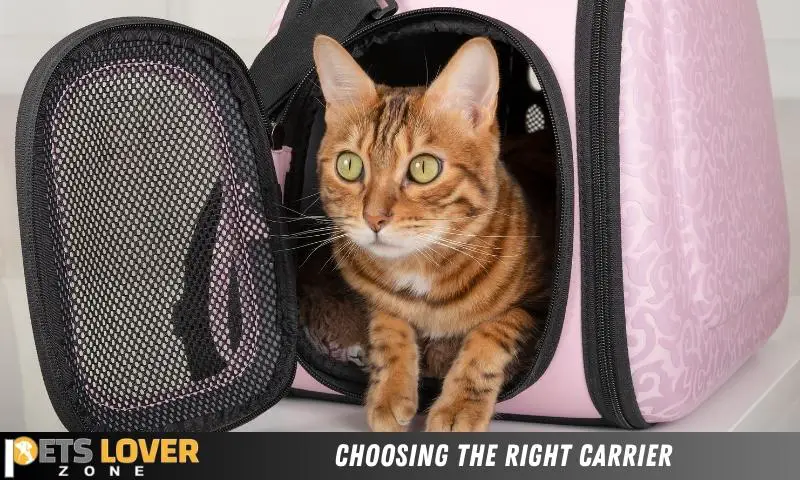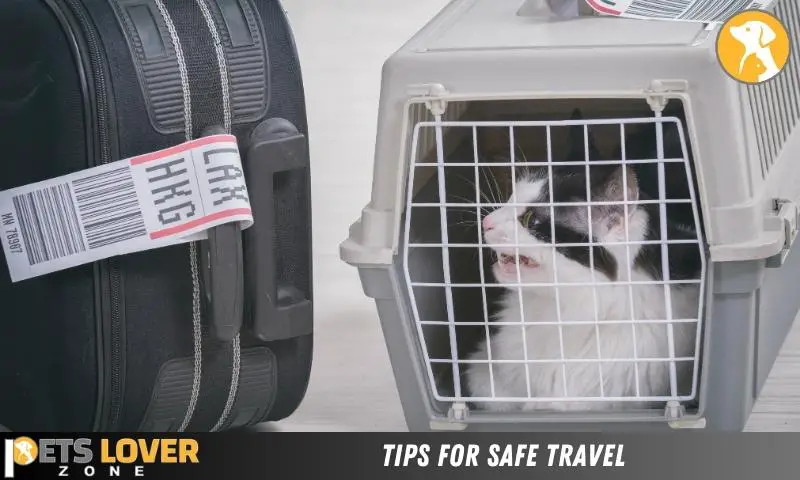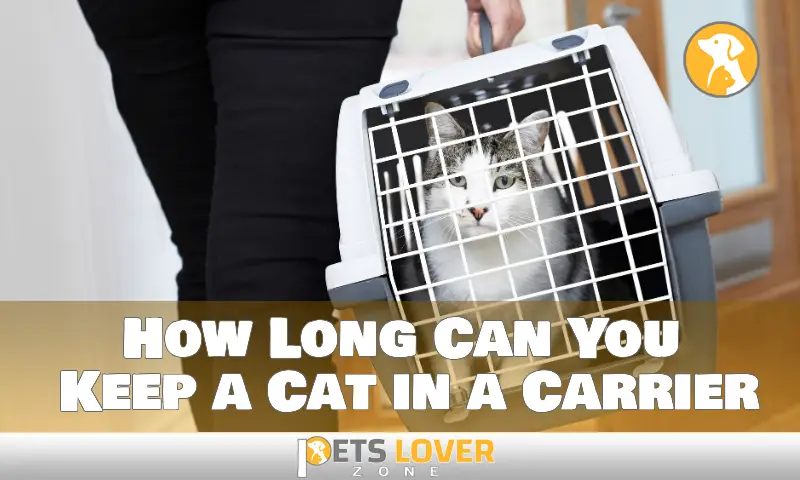You should not keep a cat in a carrier for more than two hours at a time. Cats should have access to water and food, and enough space to move around comfortably.
It’s essential to transport cats around in a carrier, whether it’s for a trip to the vet or moving to a new home. However, you must ensure that your furry friend has comfort, safety, and space, so it’s essential to know how long they can stay in a carrier.
Cats are curious animals and love to explore new environments. They also like to stretch, move around, eat, drink, and use the litter box regularly. Keeping a cat in a carrier for prolonged periods can stress them, cause anxiety, and lead to health issues. This article will explore how long it’s safe to keep a cat in a carrier and what precautions you should take to keep your feline friend happy and healthy.
Understanding Your Cat’s Needs

Cats are independent creatures, but they do have specific needs that their owners must meet. One of the most important is providing a comfortable carrier when traveling with your furry friend. Understanding your cat’s needs is crucial to ensuring they remain calm and happy while inside the carrier.
Why Cats Need Regular Movement And Exercise
A cat needs to move around, and regular exercise is essential for its health and well-being. Here’s why:
- Prevents obesity: Cats must maintain a healthy weight, and regular movement and exercise can help prevent obesity.
- Promotes healthy joints: Moving around can help keep your cat’s joints healthy and prevent arthritis.
- Mental stimulation: Exercise can provide mental stimulation, keeping your cat engaged and happy.
- Mood regulation: Exercise helps regulate serotonin levels, improving your cat’s mood.
How Long A Cat Can Go Without Food Or Water
When traveling with your cat, you’ll want to know how long they can go without food and water. Here’s what you should keep in mind:
- Food: A healthy cat can go up to five days without food, but make sure to offer them food as soon as possible.
- Water: A cat can go up to three days without water, but ideally, they should have access to it regularly.
- Age and health: Younger cats and those with health issues may need more frequent access to food and water.
Ways To Make A Carrier More Comfortable For Your Cat
If you’re traveling with your cat in a carrier, you want to make sure they’re comfortable. Here are some ways to make that happen:
- Add a soft blanket or towel: This provides a comfortable and cozy place for your cat to rest.
- Familiarize them with the carrier: Let your cat explore the carrier before the trip so they become comfortable with it.
- Opening the carrier during the trip: If possible, open the carrier (when safe) to give your cat a chance to stretch and move around.
- Fresh water and food: Make sure your cat has access to fresh water and food during the trip.
- Provide a small litter tray: Offer your cat a small litter tray to use if they need to go to the bathroom.
Understanding your cat’s needs is essential to ensuring a happy and healthy journey for them. By providing regular exercise, access to food and water, and a comfortable carrier, you’ll be able to keep your cat calm and content on the go.
Choosing The Right Carrier

Are you planning to travel with your feline friend? If yes, then one of your primary considerations should be the cat carrier. Choosing the right carrier is crucial to ensuring a comfortable and safe trip for your cat. Here are some factors to consider when selecting a carrier.
- Size: Opt for a carrier that is spacious enough for your furry friend to stand, turn around, and even lay down comfortably.
- Material: Choose a carrier made with sturdy materials that can safely carry your cat without tearing or breaking.
- Ventilation: Ensure proper ventilation in the carrier to prevent breathing difficulties.
- Security: Go for a carrier that has a locking mechanism and secure latches to ensure your feline pal doesn’t escape during the journey.
- Transport: Consider the mode of transport you will use – plane, car, or train—and select a carrier that suits your travel means.
Types Of Carriers Available And Pros And Cons Of Each
There are different types of cat carriers available, each with its own pros and cons. Here are a few examples.
- Hard-sided carriers: These are usually made from sturdy plastic and offer better protection and security. On the downside, they are heavier and come in limited sizes.
- Soft-sided carrier: These are lightweight and come in various sizes, making them ideal for car travel. However, they offer less protection and may not be durable if your cat tries to escape.
- Backpack carrier: These carriers are convenient for outdoor ventures and keep your hands free. However, their limited capacity may not make them an ideal choice for long-distance travel.
- Wheeled carrier: As the name suggests, these carriers have wheels, making it easy for transportation from one place to another. The downside is that they may not fit in car seats and can be heavier than other carriers.
How To Properly Prepare The Carrier For Travel
Proper preparation of the carrier is essential to ensure your cat is comfortable and safe during the journey. Here are some tips to prepare the carrier:
- Wash the carrier with water and mild soap, and ensure it is dry before use.
- Add a soft blanket or towel to the bottom of the carrier to provide a comfortable bed for your cat.
- Place your cat’s favorite toy or treat inside the carrier to make them feel at home.
- Ensure the door of the carrier is securely fastened before starting the journey.
Choosing the right cat carrier and preparing it appropriately for travel is the first step towards ensuring your furry friend’s safety and comfort during the journey.
Tips For Safe Travel

Carrying your furry friend in a cat carrier can be a challenging task, especially when traveling long distances. It’s essential to ensure that your cat is comfortable and safe while traveling in a carrier. Here are some tips to help you keep your cat comfortable and safe during your travels.
How To Acclimate Your Cat To The Carrier Before Travel
Acclimating your cat to the carrier can make a huge difference when it comes to stress-free travel. Here are some ways to create a positive association with the carrier:
- Leave the carrier out in a common area. Your cat will get used to the carrier’s presence and may eventually start using it as a comfortable space to sleep or relax.
- Use positive reinforcement, such as treats, catnip, or favorite toys, to get your cat inside the carrier. This will help make the carrier a familiar and safe space for your cat.
- Introduce your cat to the carrier through short trips, such as to the vet. This helps to get your cat used to the carrier’s movements, sounds, and any situations that may cause stress while traveling.
Preparing For A Long Car Trip With Your Cat
Car travel with a cat requires extensive planning to make sure that both you and your furry friend are comfortable during the trip. Below are some tips for a comfortable and safe car trip:
- Make sure the carrier is the right size for your cat and is secured safely in the car. Additionally, ensure that your cat can stretch or move freely and access food and water.
- Pack a separate bag with essential supplies such as food, water, litter, wipes, medications, and a first aid kit.
- Place familiar items such as blankets, toys, and soft bedding in the carrier to make your cat comfortable and at ease during the journey.
Air Travel Considerations And Tips
Air travel with a cat requires adequate preparation to make sure that your cat arrives at your destination safely. Here are some tips to keep in mind when traveling by air:
- Make sure to check the airline’s pet policy and requirements before booking your tickets.
- Use an appropriate, airline-approved carrier that is the right size for your cat.
- Feed your cat at least four hours before the flight, and check with your veterinarian to see if your cat needs any medication to reduce anxiety while flying.
- If possible, choose a non-stop flight to reduce the stress of going through multiple check-ins and security procedures.
- Label your carrier with your contact information in case of an emergency.
By taking the necessary measures, you can reduce your cat’s stress levels during travel and ensure that they arrive at your destination happy, healthy, and safe. Remember, every cat is different, and what works for one may not work for another, so experiment to find what works best for your furry friend.
What To Do When You Reach Your Destination
When traveling with your beloved feline friend, you want to make sure that they feel safe and secure. After reaching your destination, you need to carefully transport your cat from the carrier.
Here are some tips to help you safely transport your cat to your accommodations:
- Open the carrier’s door and give your cat time to come out on its own.
- Use a cat harness or leash to maintain control of the cat while moving them.
- Create a safe space for your cat to explore in your new surroundings.
Tips For Settling Your Cat In A New Environment
Cats love familiarity and consistency. It can be very overwhelming for them to be placed in a new environment. Here are some helpful tips to help you settle your cat in a new environment:
- Provide familiar items such as toys, blankets, and scratching posts to help your cat feel more comfortable.
- Gradually introduce the cat to your new environment by allowing them to explore a small, safe area at first.
- Stick to your cat’s routine as closely as possible, from feeding times to playtimes.
Common Mistakes To Avoid When Traveling With Cats
Traveling with cats can be a stressful experience for both you and your pet. Be aware of the common mistakes that pet owners make and try to avoid them:
- Not providing enough water or food during the trip.
- Using a carrier that is too small or uncomfortable.
- Not making sure that the cat is properly secured during transportation.
By following these tips and suggestions, both you and your feline friend will have a safe and comfortable travel experience. Happy travels!
FAQs
How Long Is It Safe To Keep A Cat In A Carrier?
It’s generally safe to keep a cat in a carrier for up to 2-4 hours.
How Often Should You Let A Cat Out Of Its Carrier?
You should let your cat out of the carrier every 2-4 hours for essential needs, including stretching and exercise.
How Can One Make A Cat’S Carrier Comfortable For Long Travel?
You can make your cat’s carrier comfortable for long travel by lining it with soft blankets and providing food, water, and toys.
Conclusion
After reading all the information given in this blog post, we hope that you gained insight into how long you can keep a cat in a carrier. Remember that before putting your cat inside the carrier, make sure to prepare it well, including introducing the carrier, providing comfort, and ensuring its safety.
Whenever possible, avoid keeping your cat inside for an extended period, and ensure to let your cat out often if you’re traveling a long distance. Ensuring your cuddly bundle of joy’s well-being is all about taking the necessary steps to make them feel comfortable so they have an enjoyable time.
Providing them with enough food, water, space, light, and air can significantly determine how well your cat will handle the stress of being confined. Just remember to stay safe and prioritize the safety of your cat!





